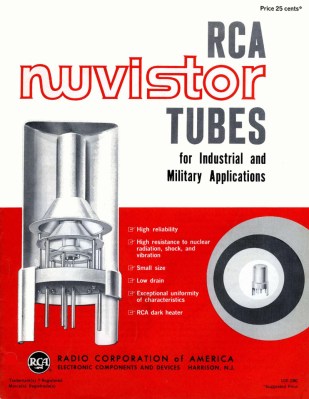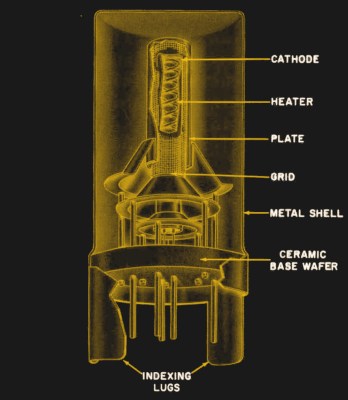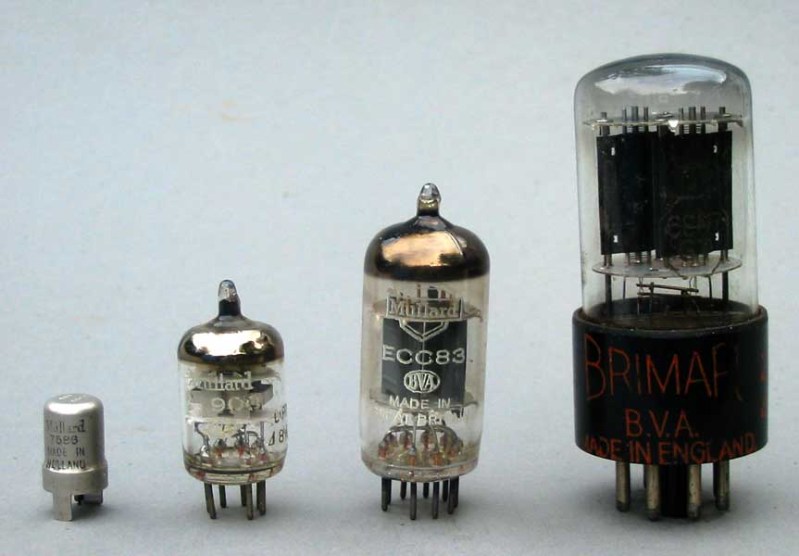In 2021 all our electronics are solid state, in that they exclusively use semiconductor devices as their active components. Some of us may experiment with vacuum tubes, but only for curiosity or aesthetic purposes. Semiconductors have overtaken vacuum devices in all but the rarest of niche applications due to their easier design requirements, greater reliability, lower cost, and increased performance.
It was not always this way though, and there was a period at the start of the semiconductor era when transistors and vacuum tubes existed together side-by-side and competed directly. Vacuum tube manufacturers continued to create new devices into the 1970s, and in doing so they pushed the boundaries of their art in unprecedented directions. [David W Knight] has a page dedicated to the Nuvistor, something his calls the “final evolution of the thermionic valve”. His comparison photo seen above shows a Nuvistor on the left — a miniature vacuum tube you’ve likely never seen before.

Towards the end of the 1950s there was an inexorable move in radio frequency applications towards ever higher frequencies that left some traditional vacuum tubes lacking. Military radar, mobile radio, and broadcast radio were starting to exploit the VHF and UHF frequency ranges, and while the available higher frequency transistors were noisy and had poor gain, their vacuum counterparts suffered from stray inductance and capacitance in their construction. Miniature tubes and other designs such as “acorn” tubes with conductors emerging from their sides had appeared to address these issues, but for RCA these were not sufficient. Their Nuvistor range of tubes named to evoke the transistor and released in 1959 were like no other vacuum devices, being miniaturised to a similar size to the transistors of the day and having metal shells with ceramic bases rather than the more common glass envelopes.
Internally they had a co-axial design of tubular electrodes stacked one above the other, and with a new socket whose connections came straight out through the base rather than being bent at an angle to meet the pins as per previous tubes. Their manufacture was unusual too, instead of being assembled before evacuation and sealing they were mechanically assembled and sealed in a vacuum chamber. It’s fairly obvious reading the various data period documentation that their intended market was military rather than civilian (Excellent performance when exposed to nuclear radiation and shock is hardly a requirement for an FM broadcast receiver!), which may explain their relative rarity in civilian use.

I first directly encountered a Nuvistor when as a student in about 1991 pursuing the Holy Grail of an entirely hollow-state Hi-Fi, I bought a 1965 Sansui TU-70 FM tuner for the princely sum of £15 (close to $50 in 2021). It uses tubes throughout including in its stereo decoder, but it’s the FM tuner that caught my interest with its pair of 6CW4 Nuvistor triodes as RF amplifiers. Their diminutive metal cans are a shade bigger than the OC170 or similar germanium VHF transistors I’d have expected to see in a tuner of that era, but mounted on a chassis in their special sockets rather than on a PCB as would the transistors. I’m old enough to have experimented with germanium RF transistors and it’s fair to say that they’re both deaf and noisy, so I can see that the Nuvistors made sense in what would have been a high-end unit when it was made. But the considerable extra expense of all their hardware over a relatively cheap PCB for the transistor must have made them an increasingly unusual choice over the decade. They still appear in RCA consumer tube manuals from the 1970s, but by the 1980s they’re gone.
The Nuvistor then. A fascinating device from the end of the vacuum tube era, they were some of the smallest high-frequency vacuum devices ever created, but sadly their arrival came too late to be more than a footnote in electronics history. If you find one don’t let it go, you may not see another.
[Main image source: Nuvistor compared to EC900, ECC83, and 6SN7, via g3ynh.info]
















The only place I recall seeing Nuvistors was in late-model TV tuners. Now I wish I had done more “dumpster diving” back then.
As a kid, I used to gut curbside TVs being thrown out for tubes, transformers, and other valuable components. I have a handful of these popped from tuners from those days, and a little searching revealed some DIY audio projects that could use them. 6.3V for filaments, and 40v for for “high voltage”. Seems reasonable, and might be a fun way to get them back in use. Anyone else seen a good use of these?
I had the same experiences….
” It’s fairly obvious reading the various data period documentation that their intended market was military rather than civilian (Excellent performance when exposed to nuclear radiation and shock is hardly a requirement for an FM broadcast receiver!), which may explain their relative rarity in civilian use.”
I imagine in the fallout universe that would have been a useful property.
In the 60’s, 70’s, and early 80’s when these were being used, nuclear apocalypse felt like it was just one bad day away.
*it was
It still is.
I first saw them in my 1965 Tek 564. Amazing, I thought at the time.
I just checked my 1973 Tek 7613. No tubes other than the loooong CRT in there, and it’s an entirely different beast from the 564. Custom integrated circuits! What an huge difference in just 8 years.
I recall my boss pointing at some older Tektronix scope, and saying they’re used miniature valves to try to get maximum gain/bandwidth performance from the channel amplifiers, but it hadn’t been very commercially successful.
The HP 141A oscilloscope from 1968 also has ’em; some of its plug-in modules are a real mishmash of miniature glass valves, nuvistors and transistors all in the same circuit. It also has a storage screen CRT, just to round out the full smorgasbord of technology.
Related: the vacuum tube equipped amplifiers in submarine telephone cables. Courage :)
https://www.radiomuseum.org/tubes/tube_175hq.html
https://www.thehenryford.org/collections-and-research/digital-collections/artifact/402976/
Had these come earlier, and in quantity, it would have made a huge difference in the development path of computers
There was one review for a Nuvistor converter, I think for 144MHz, and the author compared it to a converter using either a 416 or 417 tube. (Both were top of the line, the 416 the best of the two, expensive). And he said the Nuvistor converter beat the other one, maybe because it needed adjustment.
The point was that the cheaper Nuvistor gave great performance without a lot of finicky adjustment.
It was a transition time, and lots of things didn”t need to be top of the line. So lots of VHF/UHF ham radio equipment, but only high end consumer FM tuners.
There were even a few Nuvistors that could work with 12V plate voltage, there was a converter in an RCA Ham-Tips. And I recall a tetrode Nuvistor with a plate cap, just solder a wire to it.
But about 1964, JFets arrived, and they became the thing for low noise reception. So the window for Nuvistors was small.
I think Musical Fidelity may still manufacture some Nuvistor hi-fi equipment. Or if they don’t now, they did until relatively recently.
They still use these in a few products. For ‘reasons’ they brand the units Nuvista.
The valves are still easily available as new-old stock.
I think the problem is getting the sockets to plug them in to. PCB mount are basically imposible to find now so anyone wanting to work with these will have to use the chasis mount ones.
Tubes live on today and are still produced new, but not Nuvistors. I would hardly call audio amplifiers and musical instrument amplifiers a rare niche. They are also still used in radio broadcasting, military hardware, etc.
The Nuvistor was used in several professional microphones from AKG, Neumann, and others, including use as a replacement for the extremely rare VF14k tube in the legendary U47.
Agree, the highest end audio equipment still uses tubes (see for example the McIntosh 275 power amp).
Even a reborn Western Electric is back to making 300B triodes in the USA.
Korg makes (or made?) a tube in dual-inline package, the nutube, don’t they?
yup. Korg + Noritake:
https://korgnutube.com/en/
Whee.
-N
Yes, but it is really a VFD tube wired as triode. That and the $50/pc price makes them unattractive to anyone but Korg.
There are still Traveling-wave tubes and X-ray tubes, which definitely contain a vacuum and are tube shaped. I do not think that there will ever be an end of the use of vacuum tubes. There are many niche application where a solid state replacement does not exist or currently just can not do what is needed.
Even the, now discontinued, pyroelectric crystals used to shoot electrons into a copper plate to generate 35 kV X-rays had a vacuum in them ( https://www.amptek.com/internal-products/obsolete-products/cool-x-pyroelectric-x-ray-generator ).
There are also power triodes and pentodes for high power RF transmitters. And don’t forget the excellent photomultipliers used in physics research. And audiophiles and guitar players love their audio tubes, so some companies make them still…
Agree. I don’t foresee any solid-state X-ray sources or photomultipliers on the horizon.
I can see high power RF amplifiers becoming all solid-state. Not too long ago UHF Tx was all vacuum tube. Not no more!
And vacuum tube audio amps are just for stroking ones ego.
I consider X-ray tubes to be a primitive form of an accelerator. The solid-state X-ray source was created using packing tape – when you peel it off the roll, the glue bonds break and this emits very sort bursts of X-rays. Not very strong and not very useful…
And we forgot about the humble magnetron that lives in every microwave oven and helps us in converting a decent meal into tasteless mush since 1960’s…
And vacuum tube audio amps are just for stroking ones ego.
++++1
no, vaccum tube amps are a form of art – they have a beautiful aesthetic
art is its own innate judtification
Solid state photomultipliers have existed for at least a decade (electron multiplying charge-coupled device, EMCCD).
“Solid state” x-ray sources also exist, though they don’t really count, since the actual x-ray emission is still from high speed electrons traversing a vacuum and stopping in a high-Z material. Even inverse-Compton and synchroton sources still require a vacuum, even if they don’t smash electrons into metal targets to make the X rays.
Tubes are still used even in brand-new designs for high power digital television transmitters. New tube designs came out just to address that market, for example, the IOT (inductive output tube). You probably can’t find a DTV transmitter over 5kW that doesn’t use tube outputs. True, less than 4 kW or so has gone over to LDMOS solid-state devices.
My stations new 35kw solid state transmitter would argue that you are incorrect :-) Even our 10 year old backup DTV transmitter is over 10kw and all solid state. Granted.. the 35kw did replace a transmitter with an IOT tube.. still have a couple of them sitting around in case anyone needs a spare.
As avalanche photodiode and Silicon Photomultiplier technology continues to improve, we might see photomultipliers replaced in some applications; they’re already extensively used in LIDAR applications, including atmospheric / weather sensing LIDAR where weak signals can be expected
My Musical Fidelity Nuvista preamp feeding a Rotel RB1080 power amp is in my system for performance, not ego. It is better than the matching solid state MF X-P100 preamp
These were in widespread use in battery powered telecom test equipment at least until the mid-80s when I left that industry. Perhaps it was due to the dc voltage levels being higher that early low-cost semiconductor devices could withstand.
I remember them in broadcast tv equipment I worked on in the early 80s.. that equipment was probably manufactured in the mid to early 70s though.
With the CCP playing games with the processing of rare earth materials and the knock on effect for the semiconductor industry we might find ourselves haveing to reproduce these to build new electronic devices
You probably have a vacuum tube in your kitchen.
Nuvistors were too good perhaps. Let’s I magine, in a parallel world, Nuvistors did beat transistors and Nuvistors technology became as advanced as our FETs, minus the cons. Somehow, this is very satisfying. :)
Because, semiconductors aren’t new or ingenious, they are older than tubes, in fact. The original detector was based on real crystals and became the forerunner of todays glass diodes, which in turn gave birth to the transistor. From my experience, the crystal detector’s characteristics are even better (smoother) than that of diodes. There are a few videos on YT that support this, also. Anyway, a simple oscillograph will allows everyone to do the comparison himself/herself/thyself at home.
Personally, I had used EF95 tubes in the late 2000s, when DRM radio started its experimental phase. Not because of nostalgia, though. The receiving side consisted of a Win98/XP system running DREAM and a direct conversation receiver (12KHz IF; 7KHz IF minimum). Unfortunately, the transistor receivers were mediocre in performance. They just couldn’t handle the long wire antenna that was necessary to receive the signal. Not so the EF95 based receiver that I found in a book:
http://www.b-kainka.de/roehrfaq.htm
It performed very well and could handle strong signals! I think that’s one of both a strength of Nuvistors and tubes. They go softly into saturation if exposed to a strong signal. Transistors, even field-effect transistors, will just shut their doors. They get deaf if exposed to a strong signal, maybe even take permanent damage. Unlike electron valves. That’s one wonderful ability that easily gets forgotten. Thermionic valves are forgiving. Thus, someone can actually depend on them in extreme situations.
I think that’s overstated. Fets can suffer from static discharge, but they have to be in a very strong RF field to be damaged by signals.
In the early days of transistors, a key point was “low current”, which made many designs prone to overload. Jfets came along about 1964, and were seen as the answer to overload. But in the early seventies, a shift back to bipolars. There was an article about 1974 by Hank Cross, where he talks about running bipolars at higher current levels, of course making sure they could handle the power.
A lot of time receivers don’t face strong local signals, on ships is a well known exception. But in 1972, someone tried for a very resistant receiver in QST. They talked about using a transmitting tube for the RF stage, backed down a bit.
Good receiver design isn’t just the devices, but where the gain sits.
no red glow, no fun :)
If only they’d incorporated an orangey-red diode into the end of the can.
LED! I mean LED!
It would probably be chaper than adding a glass window on the top to peek inside
There is a nuvistor in the later AKG C28. The earlier ones used a noval tube.
Don’t forget the compaction. A single tube that had two or more other tube types in one package.
Compactron ™.
Apart from microphones, my main interaction with Nuvistors was in TV cameras when I joined the BBC in 1969, the main studio camera was the EMI 2001, probably the best SD camera ever. It used 4 tubes, one for Luminance and one each for RGB. Each tube was mounted in a tube which contained the scan coils and the head amplifier. This was at the front end and had a contact directly to the front of the tube and the photoelectric layer. The first versions of the head amp used an RCA Nuvistor as a low noise amplifier. From memory, the manufacturing of FETs couldn’t produce the repeatability necessary. The RGB amps needed to be well matched for noise performance, and it wasn’t until, I think, the mid-70s that we had replaced all the Nuvistor head amps. I remember in either 76 or 77, working with a Research Dept. team measuring the noise floor of tubes in situ. We found that with the FET amps the noise floor was down in the Quantum Noise generated in the target layers of the Phillips Plumbicon pick-up tubes!
Sometimes I wonder how the vacuum tube might have advanced if the transistor was delayed by 10-15 years.
Maybe tube IC’s?
Small 1 tube radios?
There was research done on microscopic-sized tubes using IC style fabrication. Some used field emission cathodes with ultrasharp peaks that didn’t need to be heated. Kind of like an FET without the silicon. The big problem is that vacuum just can’t conduct as much current as silicon or SiC or GaAs or GaN or any other doped semiconductor can. And they have to be hermetically sealed, not just potted with goop.
Hmm. The last big amplifier I used a tube in had 20 amps peak tube current. 10 kW output power. The tube itself was not much bigger than my thumb. With its heatsink still smaller than my fist. Thoriated cathode does the job.
What amplifier and what kind of tubes was that? Sounds like pretty extreme conditions, I’m curious!
A custom amp you would never have heard of, but it was a pulsed radar-like application. Yes, pretty extreme, right on the edge. Used a selected version of a commercially-available ($1k) genuine Eimac 3CPX800 ceramic tube, running well over its datasheet specs, but never a tube failure in years of operation. Asian clones of the tube died instantly in testing.
Ampex used Nuvistors in some preamp designs used in their two-inch quadrature-head video tape recorders back in the late 50s. I used to work on those machines back in the 80s. Our lab was filled with Nuvistors.